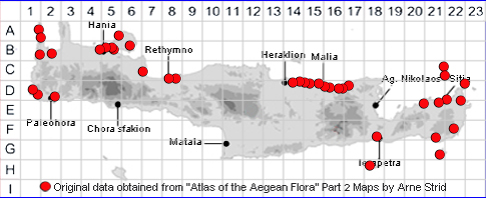ARTHROCNEMUM MACHROSTACHYUM
Family:- AMARANTHACEAE/CHENOPODIACEAE
Common Names:- Glaucous glasswort
Synonyms:- Arthrocnemum glaucum, Salicornia glauca, Salicornia
macrostachya.
Meaning:- Arthrocnemum (Gr) Jointed-thread.
Macrostachyum (Gr) With large spikes.
General description:- Much-branched, glabrous, perennial herb or subshrub.
Stems:-
a) 5-7 mm.
b) terete.
c) segmented with intemodes.
d) old stems ± woody.
e) young stems yellowish-green. succulent.
Leaves:-
a) Opposite.
b) reduced to connate scales forming a cup around the stem.
Flower:-
1) Inflorescence:
a) dense, elongate, cylindrical.
2) Flowers:
a) inconspicuous.
b) sunken in undivided cavities of the inflorescence axis.
c) with only the 1 or 2 stamens appearing.
d) extending to not more than 1/3 of the length of the segment.
Fruit:-
1) Seeds:
a) c. 0.8 x 0.5 mm.
b) oblong.
c) dark brown to blackish, finely striate, rugose-papillose.
d) endosperm abundant.
Key features:-
1) Flowers of each cyme falling to leave an undivided hollow in the segment.
2) Seeds black.
3) Testa hard (the outer coat of the seed), with small, wart-like projections
(tuberculate).
Habitat:- Rocky coastal habitats, saline depressions, saltmarshes, 0-20(-50) m.
Often gregarious and frequently the dominant halophyte of coastal saltmarshes.
Distribution:- Coastal areas throughout Greece. - Mediterranean region, also in
inland saline habitats in SW Asia. Limited occurrence on Crete mainly around
coastal areas.
Flowering time:- (July-)August to late September.
Photos by:- Fotis Samaritakis and Sarah Sells
Comments:-
The majority of the species are adapted to living in saline habitats (halophytes) or
growing in waste places (ruderals). The family is particularly predominant in
maritime habitats, and in the steppe and semi-desert regions of S.E. Europe.
SPECIES DESCRIPTION

